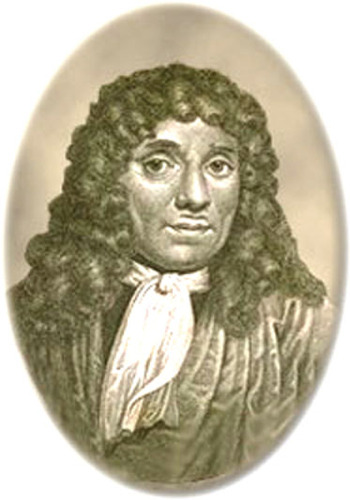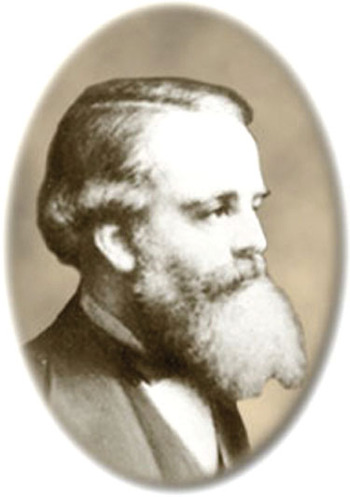
Antonie van Leeuwenhoek (1632–1723)
Leeuwenhoek was born in Delft, Holland on October 24, 1632. His father was a basket maker, and although Leeuwenhoek did not receive a university education and was not considered a scholar, his curiosity and skill allowed him to make some of the most important discoveries in the history of biology.

He was educated as a child in the town of Warmond, lived with his uncle in Benthuizen, and apprenticed in 1648 as a fabric merchant. He returned to Delft and established his own business as a fabric merchant but also worked as a surveyor, a wine assayer, and as a city official.
At some time before 1668, Antonie van Leeuwenhoek learned to grind lenses and used these to make very simple handheld microscopes. These microscopes were not compound microscopes made of two or more lenses but refined magnifying glasses made with finely ground lenses. These microscopes, with appropriate lighting, allowed him to magnify objects over 275 times. His curiosity about this microscopic world and his diligence in recording his observations allowed him to share with others what he had seen with his microscopes.
Leeuwenhoek hired an illustrator to draw what he saw, and he wrote explicit descriptions of the microorganisms he saw through his microscopes. He studied protists, plant cells, various types of algae, and was the first person to view bacteria, which he termed “animalcules.” Leeuwenhoek discovered these bacteria while viewing scrapings from his teeth and the teeth of others. He also discovered blood cells and was the first to see living sperm cells in animals.
For fifty years, Leeuwenhoek wrote letters to the Royal Society of London in which he described his findings. His letters concerning these discoveries became so famous that they were published and translated into many other languages. In 1680 he was elected a full member of the Royal Society, which was normally reserved for scientific scholars. He died on August 30, 1723 but has since been recognized as one of the most important scientists of the day.
Leeuwenhoek designed and built several hundred microscopes that were all very small and had a very similar design and function. The dimensions of his microscopes were fairly constant at approximately two inches long and one inch across. The main body of these microscopes consists of two flat and thin metal (usually brass) plates riveted together. Sandwiched between the plates was a small bi-convex lens capable of magnifications ranging from 70× to over 250×, depending on the lens quality.
James Clerk Maxwell (1831–1879)
James Clerk Maxwell was one of the greatest scientists of the nineteenth century. He is best known for the formulation of the theory of electromagnetism and in making the connection between light and electromagnetic waves. He also made significant contributions in the areas of physics, mathematics, astronomy, and engineering. He is considered by many as the father of modern physics.

Maxwell was born in Edinburgh, Scotland, in 1831. Even though most of his formal higher education took place in London, he was always drawn back to his family home in the hills of Scotland. As a young child, Maxwell was fascinated with geometry and mechanical models. When he was only 14 years old, he published his first scientific paper on the mathematics of oval curves and ellipses that he traced with pins and thread. Maxwell continued to publish papers on a variety of subjects. These included the mathematics of human perception of colors, the kinetic theory of gases, the dynamics of a spinning top, theories of soap bubbles, and many others.
Maxwell's early education took place at Edinburgh Academy and at the University of Edinburgh. In 1850 he went on to study at the University of Cambridge, and, upon graduation from Cambridge, Maxwell became a professor of natural philosophy at Marischal College in Aberdeen until 1860. He then moved to London to become a professor of natural philosophy and astronomy at King's College. In 1865, Maxwell's father died, and he returned to the family home in Scotland to devote his time to research. In 1871 he accepted a position as the first professor of experimental physics at Cambridge where he set up the world-famous Cavendish Laboratory in 1874.
While at Aberdeen, Maxwell was challenged by the subject of the Adams Prize of 1857: the motion of Saturn's rings. He had previously thought and theorized about the nature of the rings when he was only 16 years old. He decided to compete for the prize, and the next two years were taken up with developing a theory to explain the physical composition of the rings. He was finally able to demonstrate, by purely mathematical reasoning, that the stability of the rings could only be achieved if they consisted of numerous small particles. His theory won him the prize and, more significantly, about a hundred years later, the Voyager 1 space probe proved his theory right.
Much of modern technology has been developed from the basic principles of electromagnetism formulated by Maxwell. The field of electronics, including the telephone, radio, television, and radar, stem from his discoveries and formulations. Although Maxwell relied heavily on previous discoveries about electricity and magnetism, he also made a significant leap in unifying the theories of magnetism, electricity, and light. His revolutionary work lead to the development of quantum physics in the early 1900s and to Einstein's theory of relativity.
Maxwell began his work in electromagnetism by extending Michael Faraday's theories of electricity and magnetic lines of force. He then began to see the connections between the approaches of Faraday, Reimann, and Gauss. As a result, he was able to derive one of the most elegant theories yet formulated. Using four equations, he described and quantified the relationships between electricity, magnetism, and the propagation of electromagnetic waves. The equations are now known as Maxwell's Equations.
One of the first things that Maxwell did with the equations was to calculate the speed of an electromagnetic wave and found that it was almost identical to the speed of light. Based on this discovery, he was the first to propose that light was an electromagnetic wave. In 1862 Maxwell wrote, “We can scarcely avoid the conclusion that light consists in the transverse undulations of the same medium which is the cause of electric and magnetic phenomena.”
This was a remarkable achievement, for it not only unifies the theories of electricity and magnetism, but of optics as well. Electricity, magnetism, and light can now be understood as aspects of a single phenomenon: electromagnetic waves.
Maxwell also described the thermodynamic properties of gas molecules using statistical mechanics. His improvements to the kinetic theory of gases included showing that temperature and heat are caused only by molecular movement. Though Maxwell did not originate the kinetic theory, he was the first to apply probability and statistics to describe temperature changes at the molecular level. His theory is still widely used by scientists as a model for rarefied gases and plasmas.
Maxwell also contributed to the development of color photography. His analysis of color perception led to his invention of the trichromatic process. By using red, green, and blue filters, he created the first color photograph. The trichromatic process is the basis of modern color photography.
Maxwell's particular gift was in applying mathematical reasoning in solving complex theoretical problems. Maxwell's Electromagnetic Equations are perfect examples of how mathematics can be used to provide relatively simple and elegant explanations of the complex mysteries of the universe. Richard Feynman wrote of Maxwell, “From a long view of the history of mankind, seen from, say, ten thousand years from now, there can be little doubt that the most significant event of the nineteenth century will be judged as Maxwell's discovery of the laws of electrodynamics.”
Maxwell continued his work at the Cavendish Laboratory until illness forced him to resign in 1879. He returned to Scotland and died soon afterward. He was buried with little ceremony in a small churchyard in the village of Parton in Scotland.


